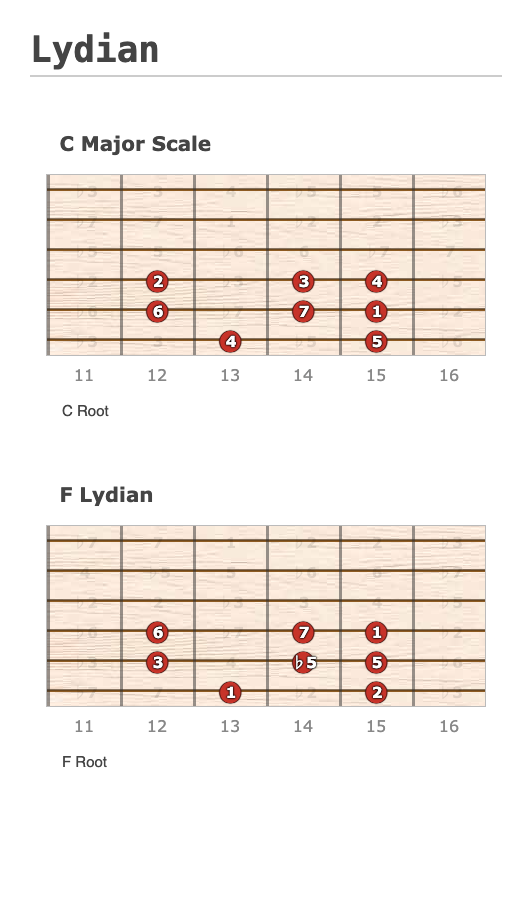Mixolydian
Introduction
The Mixolydian mode is a famous musical mode in genres like blues, rock, and folk, offering a major scale sound with a flattened seventh (♭7). This subtle alteration creates a distinct “dominant” vibe, blending brightness with a touch of tension. Let’s explore its structure, emotional impact, and practical uses.
Structure of the Mixolydian Mode
The Mixolydian mode is the fifth mode of the major scale. Its formula is:
1, 2, 3, 4, 5, 6, ♭7
Each mode has its own unique formula of intervals (whole and half steps). For any given root note, we can apply the formula to create each of the seven modes for that root. The Lydian mode has the following interval formula:
Intervals:
- Root
- Major 2nd
- Major 3rd
- Perfect 4th
- Perfect 5th
- Major 6th
- Minor 7th (♭7)
In other words, the interval formula is W – W – H – W – W – H – W (Whole and half steps).
Example:
Notes of the C Mixolydian Scale: C – D – E – F – G – A – B♭ – C
Formula Comparison:
| Mode | Formula (Relative to Major) | Example (C) |
|---|---|---|
| Ionian | 1-2-3-4-5-6-7 | C-D-E-F-G-A-B |
| Mixolydian | 1-2-3-4-5-6-♭7 | C-D-E-F-G-A-B♭ |
Mixolydian in Action
Iconic Examples:
- “Sweet Child O’ Mine” (Guns N’ Roses) – Uses D Mixolydian in the main riff.
- “Scarborough Fair” (Traditional Folk) – Melody leans on Mixolydian’s ♭7.
- “All Blues” (Miles Davis) – Jazz classic with a Mixolydian backbone.
How to Play Mixolydian
Guitar (G Mixolydian Pattern):
e|-----------------3-5-
B|-------------3-5-----
G|---------4-5---------
D|-----5-7-------------
A|-5-7-----------------
E|---------------------Constructing Lydian Mode
The fourth note of the major scale as root note is Lydian.
Why Use Mixolydian?
- Dominant Harmony: The ♭7 creates a dominant 7th chord (e.g., G7 in G Mixolydian), ideal for blues and rock progressions.
- Bluesy Flexibility: Balances major-scale brightness with minor-like tension.
- No Leading Tone: The ♭7 avoids the strong resolution of the major scale, lending a “laid-back” feel.
Mixolydian vs. Other Modes
| Mode | Scale Degrees | Emotional Quality | Example (C) |
|---|---|---|---|
| Ionian | 1-2-3-4-5-6-7 | Bright, resolved | C-D-E-F-G-A-B |
| Aeolian | 1-2-♭3-4-5-♭6-♭7 | Melancholic, minor | C-D-E♭-F-G-A♭-B♭ |
| Dorian | 1-2-♭3-4-5-6-♭7 | Soulful, jazzy minor | C-D-E♭-F-G-A-B♭ |
| Mixolydian | 1-2-3-4-5-6-♭7 | Bluesy, dominant | C-D-E-F-G-A-B♭ |
Tips for Composers
- Pair with Dominant Chords: Use Mixolydian over 7th chords (e.g., C Mixolydian over C7).
- Emphasize the ♭7: Highlight B♭ in C Mixolydian for tension.
- Blend with Pentatonics: Mix Mixolydian with the minor pentatonic for solos (e.g., G Mixolydian + G minor pentatonic).
Chord Quality
Diatonic 7th Chords in Lydian Mode
| Degree | Chord Type | Example (C Mixolydian) | Notes | Function |
|---|---|---|---|---|
| I | Dominant 7th | C7 | C, E, G, B♭ | Tonic with bluesy tension |
| ii | Minor 7th | Dm7 | D, F, A, C | Adds soulful contrast |
| iii | Minor 7♭5 (Half-dim) | Em7♭5 | E, G, B♭, D | Tense, jazzy transition |
| IV | Major 7th | Fmaj7 | F, A, C, E | Bright, stable resolution |
| v | Minor 7th | Gm7 | G, B♭, D, F | Subdued, moody movement |
| vi | Minor 7th | Am7 | A, C, E, G | Melancholic, reflective |
| VII | Major 7th | B♭maj7 | B♭, D, F, A | Airy, ambiguous resolution |
Common Chord Progressions
- Rock: G – C – D – G (G Mixolydian over G7)
- Blues: A7 – D7 – A7 – E7 (A Mixolydian for dominant 7th chords).
- I-IV-V
- Example in C Major : C - F - G
- Adaptation for C Mixolydian : C7 - F - G (using dominant seventh for a bluesy feel)
- I-V-vi-IV
- Example in C Major : C - G - Am - F
- Adaptation for C Mixolydian : C7 - G - Am - F (mixing major and minor chords)
- vi-IV-I-V
- Example in C Major : Am - F - C - G
- Adaptation for C Mixolydian : Am - F - C7 - G (starting with a minor chord)
- ii-V-I
- Example in C Major : Dm - G - C
- Adaptation for C Mixolydian : Dm7 - G7 - C7 (using minor and dominant seventh chords)
- Circle Progressions
- Example : vi-ii-V-I
- Adaptation for C Mixolydian : Am - Dm7 - G7 - C7
FAQ
Why the ♭7?
It replaces the major scale’s leading tone (B in C major), creating a “hang in mid-air” tension perfect for blues and rock.
Is Mixolydian major or minor?
Major (due to the major 3rd), but the ♭7 adds a hybrid quality.
How to practice?
- Play over a drone or looped dominant chord.
- Improvise using the ♭7 as a focal point.
